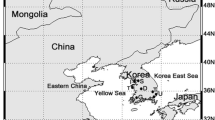Abstract
Obvious tendency and periodicity of the air temperature can be detected over the North Pole area. They are reflected as follows: a. the air temperature at the earth surface and in the middle layer of the stratosphere tends to be increased either in winter or in summer. The air temperature has increased 1.3 °C for about 50 years at a speed about 0.025 °C/year in January, and 0.013 °C/year in July. The air temperature in the middle layer of the stratosphere (10 hPa) in January has increased 10 °C. The temperature rising speed in July is 0.14 °C/year. Generally speaking, the temperature rising speed is quicker in winter than in summer and quicker in the upper layer than at the earth surface. b. The air temperature at the top layer of the troposphere (100 hPa) over the North Pole area tends to be increased either in winter or in summer. The air temperature in January has decreased 5.0 °C for about 50 years at a temperature decreasing speed about 0.094 °C/year, and at a temperature decreasing speed about 0.032 °C/year in July. The speed of the temperature decreasing is greater in winter than in summer. c. Periodicity. The air temperature respectively at different altitudes over the North Pole possesses interdecadal variation with a period of 22 years. In July the amplitude of the variation with a period of 22 years decreases rapidly from the high altitude to the low. This means that the 22-year’s period is more obvious at the high altitude than at the low altitude. At the earth surface layer in North Pole there also is obvious decadal variation with a period of 11 years. The analysis indicates that the 22-years’ period temperature variation is associated with the periodic variation of the solar magnetic field. The 11-year period temperature variation is corresponding to 11 year’ period of the variation of the sunspot number.
Similar content being viewed by others
References
Billings W D. 1982. Arctic Tundra: A Source or Sink for Atmospheric Carbon Dioxide in a Changing Environment? Oecologia, 53: 7–8
Chen L Q. 2002. Study on the Role of the Arctic and Antarctic Regions in Global Change. Earth Science Frontiers, 9(2): 245–254
Chapman W L, Walsh J E. 1993. Recent Variation of Sea Ice and Air Temperatures in High Latitudes. Bull Am Meteorology Society, 74(1): 33–47
Chen L, Zhang Q S, Zhu L P. 2000. A Comparative Analysis of Temperature Change in Arctic and China Since 400a Bp. Geographical Research, 19(4): 344–350
Fang J Y, Wei M H. 1998. Carbon Cycle in the Arctic Terrestrial Ecosystems in RelationTo the Clobal Warming. Acta Scientiae Circumstantiate, 18(2): 111–120
Foukal P V. 1990. Changeable Sun. Scientific American, 262(2): 8–15
Gong D Y, Wang S W. 2002. Uncertainties in The Global Warming Studies. Science Frontiers, 9(2): 371–376
Greenland Ice-Core Project (GRIP) Members. 1993. Temperature Instability During the Last Interglacial Period Recorded in the GRIP Ice Core. Nature, 364: 204–207
Hansen J and S L Ebedeff. 1998. Global Surface Air Temperature: Update Through 1987. Geophys Res Lett, 15: 323–326
Oechel W C, Vourlitis G L. 1995. Changes In Arctic CO2 Flux over Two Decades: Effect of Temperature Change at Barrow. Alaska Ecological Applications, 5: 846.26
Suess H E. Climatic Change. 1968. Solar Activity and the Cosmic-Ray Production Rate of Wateral Radiocarbon. Meteorological Monographs, 8(30): 1–56
Qu W Z, Deng S G. 2004. Response to the Sun Activity of Change of Temperature of Deep Sea. Quaternary Sciences, 24(3): 285–292
Qu W Z, Deng S G, Huang F, et al. 2004. The Influence of Magnetic Index Abnormal Change in Solar Magnetic Field on Temperature at Middle Latitude of North Hemisphere. Chinese Journal of Geophysics, 47(3): 398–404
Rigor I G, Colony R L, Martin S. 2000. Variation in Sun Face Air Temperature Observations in the Arctic, 1979–1997. J Temperature, 3(5): 896–914
Wang G, Zhang Q S. 1998. Features of Temperature Change over the Last 400 Years at Barrow. Arctic Chinese Journal of Polar Research, 10(1): 11–16
Qu Weizheng, Zhu Xiaojie. 2010. Stimulation of the North Atlantic Oscillation by Volcano activities. Acta Oceanologica sinica, 32(2): 54–65
Whiting G J, Bartlett D S, Fan S, et al. 1992. Biosphere/Air CO2 Exchange in Tundra Ecosystems: Community Featureistics and Relationships with Multispectral Surface Reflectance. J Geophys Res, 97(D15): 16671–16680
Author information
Authors and Affiliations
Corresponding author
Additional information
Foundation item: The Global Change Research Program of China under contract No. 2010CB951403, and the National Natural Science Foundations of China under contract No. 40875041.
Rights and permissions
About this article
Cite this article
Qu, W., Zhao, J., Du, L. et al. Interdecadal and decadal variation of temperature over North Pole area and the relation with solar activity. Acta Oceanol. Sin. 30, 53–61 (2011). https://doi.org/10.1007/s13131-011-0105-8
Received:
Accepted:
Published:
Issue Date:
DOI: https://doi.org/10.1007/s13131-011-0105-8



